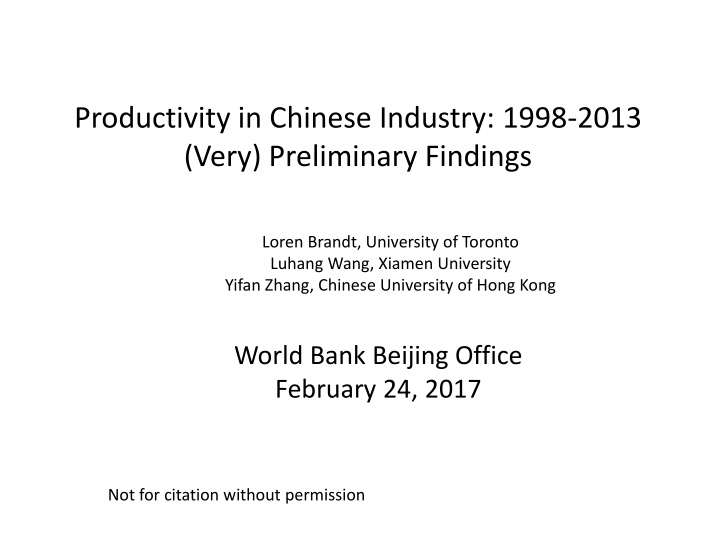
Productivity Trends in Chinese Industry: 1998-2013 Insights
This study presents preliminary findings on productivity trends in Chinese industry from 1998 to 2013. It discusses the extension of existing databases, construction of value-added measures, differences across sectors, and a broad decline in TFP growth. The analysis highlights contributing factors to TFP growth improvement, including incumbent firms, reallocation, entry of high-productivity firms, and exit of lower-productivity firms.
Download Presentation

Please find below an Image/Link to download the presentation.
The content on the website is provided AS IS for your information and personal use only. It may not be sold, licensed, or shared on other websites without obtaining consent from the author. If you encounter any issues during the download, it is possible that the publisher has removed the file from their server.
You are allowed to download the files provided on this website for personal or commercial use, subject to the condition that they are used lawfully. All files are the property of their respective owners.
The content on the website is provided AS IS for your information and personal use only. It may not be sold, licensed, or shared on other websites without obtaining consent from the author.
E N D
Presentation Transcript
Productivity in Chinese Industry: 1998-2013 (Very) Preliminary Findings Loren Brandt, University of Toronto Luhang Wang, Xiamen University Yifan Zhang, Chinese University of Hong Kong World Bank Beijing Office February 24, 2017 Not for citation without permission
Summary Extend existing 1998-2007 NBS above-scale database to include 2008, 2011-2013 Link firms overtime by name and IDs Construct estimates of VA and real capital stocks Update input and output deflators Alternative definitions of State-owned (type versus paid in capital) Construct productivity estimates for later years Use production function estimates for translog for 1998-2007 to estimate revenue TFP at firm level Aggregate firm level estimates to obtain sector and industry-wide TFP measures Data/Empirical Issues Size threshold increases from 5 to 20 million RMB Possible change in reporting of firm employment in 2013 Revenue TFP may confound changes in TFP and markups (price/MC) Changes in underlying production technology
Construction of Value Added Firms Value Added Growth in VA Year Number Reported Calculated Imputed 1998 1999 2000 2001 2002 2003 2004 2005 2006 2007 2008 2011 2012 2013 165,039 161,972 162,820 168,985 181,500 196,168 279,068 271,788 301,906 336,698 411,403 300,685 309,460 342,953 1.94 2.16 2.54 2.79 3.30 4.20 5.70 7.22 9.11 11.70 1.94 2.16 2.54 2.79 3.30 4.20 5.65 7.20 9.10 11.67 2.33 2.52 2.96 3.15 3.64 4.47 5.77 7.07 8.78 11.46 13.24 19.36 23.39 27.11 11% 18% 10% 18% 27% 36% 27% 26% 28% 11% 18% 10% 18% 27% 35% 27% 26% 28% 9% 17% 7% 15% 23% 29% 22% 24% 30% 16% 21% 16% Note: When imputing Value Added: 1. Wage = Wage bill * sector multiplier 2. Input=output*salescost/salesrevenue - wage - depreciation
Contributing Margins to TFP Growth Improvement among incumbent firms (Within) Reallocation towards better firms (Between) Entry of higher productivity firms (Entry) Exit of lower productivity firms (Exit)
Size of the State Sector Def 1: Ownership Type Def 2: Paid in Capital Def 3: Either Year # of firms % 38.0 35.6 30.8 24.7 20.8 16.2 12.5 9.5 7.8 5.8 4.8 5.2 5.0 4.6 GVIO % 44.8 42.9 41.2 36.9 34.5 31.1 28.0 27.4 25.7 23.7 22.9 21.6 20.6 18.1 # of firms % 37.4 34.6 29.2 23.7 19.6 14.9 11.0 8.2 6.8 4.1 3.5 2.9 3.6 4.5 GVIO % 38.9 37.4 34.2 30.1 27.0 24.3 20.9 19.6 18.1 15.9 15.1 11.6 13.0 14.4 # of firms % 42.8 40.1 35.1 29.0 24.8 19.5 14.5 11.8 9.9 7.2 6.2 6.5 7.0 7.6 GVIO % 49.9 48.0 46.1 42.4 39.7 36.1 32.0 31.3 29.6 27.5 26.3 24.6 24.4 23.3 VA % 58.9 57.6 56.0 52.7 50.4 47.6 41.4 39.3 37.0 34.1 30.6 34.6 30.4 29.4 1998 1999 2000 2001 2002 2003 2004 2005 2006 2007 2008 2011 2012 2013
Role of 20 million Size Threshold Firms Share of Total Year Number Number Output Employment Capital Stock 1998 1999 2000 2001 2002 2003 2004 2005 2006 2007 2008 2011 2012 2013 97,729 93,548 90,548 92,763 95,923 99,794 147,728 125,553 128,608 128,888 165,550 3,314 3,417 3,161 66.9 65.2 62.7 61.4 59.1 55.1 58.0 50.0 46.1 41.3 43.4 1.2 1.2 1.0 12.8 11.5 9.9 9.5 8.6 7.3 8.2 5.9 4.9 3.9 4.1 0.1 0.1 0.0 30.3 28.6 26.3 26.1 24.3 22.1 23.9 18.9 16.7 14.2 14.7 0.5 0.6 0.7 15.9 15.6 13.9 13.0 12.3 10.7 11.3 8.7 7.8 6.2 6.6 0.2 0.1 0.3
Very Tentative Findings Significant decline in TFP after mid-2000s Spans most sectors at two-digit 2008-2013 tfp growth appears to be negligible Consistent with more aggregate exercises (Dollar, 2017) Premium of non-state firms over state at the 2 digit level disappears and becomes negative on average .. Less dynamic private sector? Contribution of entry diminished, and not offset by improvement on other margins Big Question (1): Was the high productivity growth between 1998-2007 a product of one- time gains? WTO entry Reduction in barriers to entry Retreat of SOEs in non-strategic sectors Increased labor mobility Big question (2): What is underlying the sharp reduction in productivity growth after 2007? Huge Caveat: Important measurement issues and challenges






















